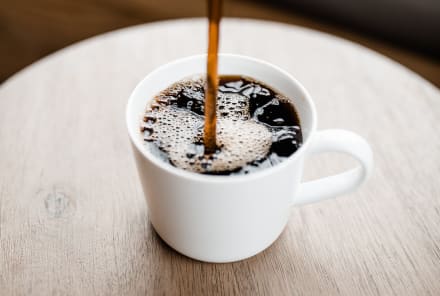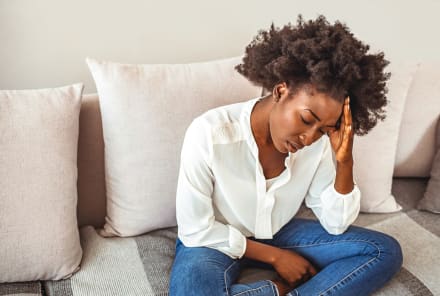Advertisement
I'm A Gastroenterologist: These Are The 2 Main Reasons You're Constipated


Virtually 100% of patients with constipation have gas and bloating. It's the most common manifestation of inadequate evacuation. But there are a number of other symptoms that are quite common with constipation: abdominal pain virtually anywhere in the abdomen, nausea or queasiness, getting full quickly after a meal, loss of appetite or food aversion, even acid reflux. There's often fatigue and sometimes brain fog. Many of my patients will show me a photo of themselves at 7 a.m. with a flat stomach and then a second photo at 10 a.m. showing a protuberant, pregnancy-like belly. That's almost always constipation behind that.
How to know if you're constipated.
To know whether you have constipation, the best test is to get imaging. You can do either an abdominal X-ray or a CT scan. In either case, it helps if you ask the radiologist specifically to answer whether there is constipation. The problem is that the radiologist reads dozens of studies per day; hasn't heard your story, let alone met you; and tends to not focus on the poop. As a result, radiology studies are often read as "normal," but closer inspection reveals constipation that correlates with and explains the symptoms.
It's for this reason that I review all imaging studies myself so that I can connect what I'm seeing with my own eyes to the story that my patient is describing for me.
Nearly everyone with constipation will also experience food sensitivities. These sensitivities are typically pretty nonspecific, meaning that they are sensitive to many different foods and also there doesn't seem to be a reproducible pattern to the symptoms. The problem in this case is the constipation and generally not the food itself. These food sensitivities will improve, and many times completely disappear, when the constipation is adequately treated.
The importance of establishing rhythm.
The solution is to establish rhythm. Your body thrives on rhythm. When we are constipated, we are out of rhythm, out of balance. We need to get things moving once more and get into that flow state where bowel movements are effortless, complete, and, frankly, enjoyable. I am being totally serious—having a good, healthy bowel movement absolutely should be one of the highlights of your day! You should look forward to it and feel satisfied afterward. If you don't, we have work to do.
I don't recommend making dietary changes while you're constipated because constipation amplifies and fuels food sensitivities. If you start adding more plants to your diet, you'll often feel gassy and bloated and have worsening abdominal pain. Instead, focus first on restoring rhythm. Once you are in a rhythm, having good regular and complete evacuations, you will feel so much better and also be in the best position to start adding back foods without food sensitivity standing in the way.
Two main causes of constipation.
In order to restore rhythm, you must first understand that there are two main contributors to constipation:
1. Slow motility
First is motility. People with slow motility struggle to adequately empty their bowels. This often manifests with a hard, lumpy, bumpy stool that has cracks and crevices in it or comes out like a golf ball. The solution here is to help move things along, which we can often accomplish through natural means.
What to do:
- Drink at least six (ideally eight) glasses of water per day. Your poop is a log. We need to float that log down the river. Don't let it get dried up on the rocks.
- Ramp up your physical activity. When you move, your colon moves to expel both poop and gas. That's what we're trying to accomplish, right?
- Slowly increase your fiber intake. Increased fiber intake can often help get the bowels moving. Consider introducing prunes, oats, ground flax, or chia seeds and slowly increasing over time.
- Consider a fiber supplement. I'm a big believer and have had tremendous success with them in my clinic. Some of the options include wheat dextrin, acacia powder, psyllium husk, partially hydrolyzed guar gum, and glucomannan. Always start low and go slow. If you feel like it's making things worse, back off.
- Add magnesium before bedtime. Magnesium is great for sleep, anxiety, headaches, and also constipation. Generally, you want to opt for magnesium oxide, magnesium citrate, or magnesium sulfate. The dosing depends on the formulation, and your magnesium level should be checked before starting and once you reach a steady dose.
2. Poor pelvic floor health
As recently as a few years ago, we only really thought of constipation in terms of motility. Unfortunately, we were missing something very important. Motility is important, but it's impossible to poop if you can't relax your butt muscles. I don't mean the glutes/booty/bum. I'm referring to your anal canal and four additional muscles that comprise the pelvic floor. They're there to prevent incontinence, and thankfully, they usually work pretty well. That barrier is designed to keep our underwear fresh until we're hovering over a commode and consciously choose to initiate a sequence of synchronized pelvic muscle relaxations that clear a path for a microbial torpedo to launch. Unfortunately, many of us take for granted that when we want to poop, these pelvic muscles will behave the way we're asking them to. That's not the reality for many of my patients and perhaps some of you.
There's a condition called pelvic dyssynergia, where the muscles fail to relax when they're supposed to, and in some cases, they actually contract. This results in a scenario where the only way to poop is to strain and push, often to have a small little nugget slip out. Or, people experience weird poop shapes or feel like they can never completely empty. Another symptom is going once, then returning to the bathroom 45 minutes later to go again. All of these point to pelvic dyssynergia.
What to do:
For many, treatment requires working with a pelvic therapist, which is effectively a physical therapist who specializes in pelvic floor issues—both bowel and urinary. However, one thing you can try first is to simply orient your pelvic muscles in a proper position on the toilet. Here's how you do it:
- sit with your knees higher than your hips (use a footstool or other flat, stable object if necessary)
- lean forward and put your elbows on your knees
- relax and bulge out your stomach
- straighten your spine
In some cases, constipation does not respond to first-line interventions. Further testing with anorectal manometry and defecography are warranted at this point. It's important to work with a qualified health practitioner from the beginning to make sure that your plan is properly fitted to your needs.
From THE FIBER-FUELED COOKBOOK: Inspiring Plant-Based Recipes To Turbocharge Your Health by Will Bulsiewicz, M.D., MSCI, recipes by Alexandra Caspero, R.D., to be published on May 17, 2022, by Avery, an imprint of Penguin Publishing Group, a division of Penguin Random House, LLC. Copyright © 2022 by Will Bulsiewicz, M.D.
Watch Next
Enjoy some of our favorite clips from classes
Enjoy some of our favorite clips from classes
What Is Meditation?
Mindfulness/Spirituality | Light Watkins
Box Breathing
Mindfulness/Spirituality | Gwen Dittmar
What Breathwork Can Address
Mindfulness/Spirituality | Gwen Dittmar
The 8 Limbs of Yoga - What is Asana?
Yoga | Caley Alyssa
Two Standing Postures to Open Up Tight Hips
Yoga | Caley Alyssa
How Plants Can Optimize Athletic Performance
Nutrition | Rich Roll
What to Eat Before a Workout
Nutrition | Rich Roll
How Ayurveda Helps Us Navigate Modern Life
Nutrition | Sahara Rose
Messages About Love & Relationships
Love & Relationships | Esther Perel
Love Languages
Love & Relationships | Esther Perel
What Is Meditation?
Box Breathing
What Breathwork Can Address
The 8 Limbs of Yoga - What is Asana?
Two Standing Postures to Open Up Tight Hips
How Plants Can Optimize Athletic Performance
What to Eat Before a Workout
How Ayurveda Helps Us Navigate Modern Life
Messages About Love & Relationships
Love Languages
Advertisement

New Study Confirms The 3 Habits That Age Your Brain Faster
Molly Knudsen, M.S., RDN
















